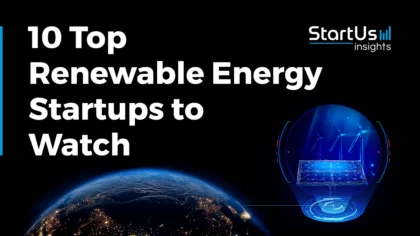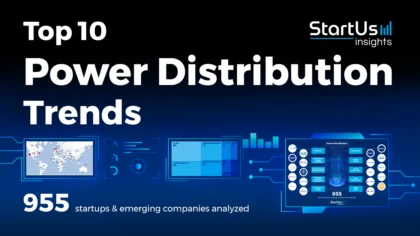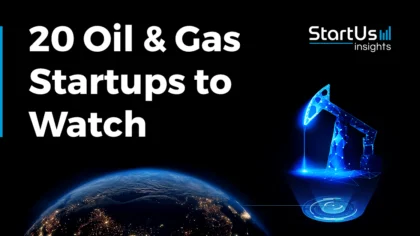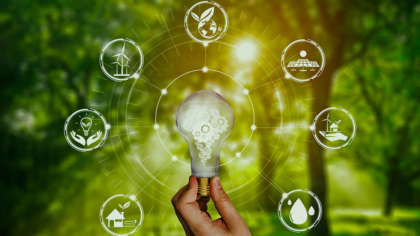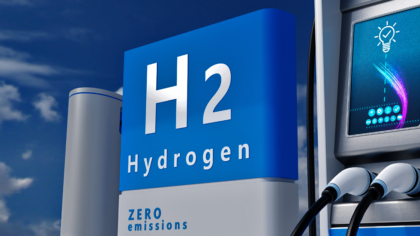The adoption of sustainable practices in the energy industry addresses challenges like greenhouse gas emissions, dependence on fossil fuels, and geopolitical risks. Sustainable energy solutions like smart grids and decentralized systems modify energy distribution patterns by modifying existing infrastructure. For instance, Dutch startup Tibo Energy addresses grid congestion and network inefficiencies with AI-powered energy management software.
Similarly, U.S-based Inlyte Energy offers a sustainable energy storage alternative through a sodium metal halide grid battery system. This technology is made from readily available raw materials like iron and sodium, addressing environmental concerns and supply-chain limitations. As sustainable energy storage, predictive maintenance, and waste-to-energy innovations gain momentum, stakeholders must embrace these innovations to thrive in a transforming marketplace.
Why should you read this report?
- Gain insights into the top 8 use cases of sustainability in the energy industry
- Learn about two practical use cases for each use case
- Meet 8 innovative startups advancing these applications

Key Takeaways
- Smart Grids and Decentralized Systems
- Use Cases:
- Microgrids
- Demand Response
- Startup to Watch: Tibo Energy
- Use Cases:
- Renewable Energy Integration
- Use Cases:
- Hybrid Energy Systems
- Grid-Forming Inverters
- Startup to Watch: Latimer Controls
- Use Cases:
- Energy Storage Solutions>
- Use Cases:
- Hydrogen Storage
- Thermal Energy Storage
- Startup to Watch: Inlyte Energy
- Use Cases:
- Predictive Maintenance for Energy Assets
- Use Cases:
- Early Fault Detection
- Condition Monitoring
- Startup to Watch: Silogic Technology
- Use Cases:
- Carbon Footprint Reduction
- Use Cases:
- Low-Carbon Fuels
- Carbon Capture and Storage
- Startup to Watch: Air View Engineering
- Use Cases:
- Smart Homes and Buildings
- Use Cases:
- Smart Climate Control
- Real-Time Energy Monitoring
- Startup to Watch: PMTech IT
- Use Cases:
- Sustainable Transportation Solutions
- Use Cases:
- Renewable Fuels
- Electrification
- Startup to Watch: Kite Mobility
- Use Cases:
- Waste-to-Energy Innovations
- Use Cases:
- Advanced Gasification
- Anaerobic Digestion
- Startup to Watch: Univastum
- Use Cases:
FAQs: Top Applications of Sustainability in Energy
1. What are the applications of sustainable energy?
Sustainable energy powers various critical sectors, supporting cleaner operations and reducing carbon footprints. In transportation, renewable energy drives electric vehicles and public transit systems, integrating with charging infrastructure that relies on wind, solar, and hydropower. Within buildings, sustainable energy applications include green heating, cooling, and lighting systems, all of which utilize solar panels and geothermal energy for greater efficiency.
Industrial operations apply sustainable energy by leveraging solar-powered machinery and bioenergy, thus enhancing productivity while minimizing environmental impact. Finally, in agriculture, renewable energy supports sustainable farming, such as by powering irrigation systems and machinery with solar and wind resources.
2. What are some examples of sustainability in the energy industry?
The energy industry showcases several key sustainability practices that directly impact operations and resource management. For instance, many companies focus on transitioning to renewable sources, with solar farms and wind farms now generating significant portions of national energy grids. Carbon capture and storage (CCS) is another critical technology that energy providers implement to trap and store emissions from industrial processes, thus minimizing greenhouse gases released into the atmosphere.
Additionally, grid modernization allows for the integration of renewable energy sources and smarter distribution, which reduces energy loss and optimizes consumption. Lastly, energy companies are investing in eco-friendly materials and circular economy initiatives, recycling resources and equipment to extend their operational lifecycles while reducing waste.
Where We Get Our Data From
StartUs Insights gathers data through its exhaustive Discovery Platform, covering information on 4.7+ million startups, scaleups, and tech companies globally, alongside 20K+ emerging technologies and trends. The Discovery Platform accelerates startup and technology scouting, trend intelligence, and patent searches, offering thorough insights into technological advancements.
By leveraging the trend intelligence feature for this report, we identified emerging technologies within specific industries. This process allows us to uncover patterns and trends, and pinpoint relevant use cases and the startups creating solutions for each scenario. Additional capabilities and information can be found at StartUs Insights Discovery Platform.
Top 8 Use Cases of Sustainability in Energy Industry [2025 & Beyond]
1. Smart Grids and Decentralized Systems
Smart grids and decentralized energy systems optimize energy distribution and allow consumers to tackle fluctuations in energy supply. Microgrids enable independent operation from the main power grid which improves grid stability in remote locations. Smart grids optimize utilities to balance load during peak periods and assist in energy delivery.
Demand response technologies balance supply and demand without additional power generation, improve the efficiency of the grid, and leave a smaller carbon footprint. For example, In the United States, platforms like GridRewards allow consumers with smart thermostats to participate in demand response programs during peak summer seasons in New York. This combination of microgrids and demand response technologies plays an important role in achieving a more resilient and sustainable electricity grid.
Dive Deeper:
- Noteworthy Example: Schneider Electric launches smart grid and digital energy solutions that optimize the management of energy flows at Enlit Europe 2024. The solution focuses on grid flexibility, grid resilience, and net zero dashboards.
- Financial Landscape: Startups working on sustainable smart grids and decentralized solutions receive an average funding of USD 27.7 million.
Startup to Watch: Tibo Energy
Dutch startup Tibo Energy offers smart grid management solutions using its proprietary AI-powered energy management software (EMS). It optimizes existing infrastructure by creating a digital twin of the energy network to analyze power distribution which prevents congestion and improves network performance. The software allows integration into existing assets and performs complex calculations of different scenarios using real-time simulation techniques. This system monitors grid conditions and adjusts the power flow to minimize waste and prevent overloads. The company’s data-driven approach optimizes energy flows, reduces costs, and improves sustainability.
2. Renewable Energy Integration
Integration of renewable energy sources like solar, wind, and geothermal into the existing grid reduces the dependence on limited fossil fuels and mitigates the impact of price changes. Hybrid energy systems (HES) combine the integration of various renewable energy sources with energy storage devices like batteries. They store excess energy generated during peak production times and release renewable when energy generation dips which maintains a steady energy flow. It offers short-term high power output and long-term energy storage which becomes essential after renewable energy integration.
Grid-forming inverters operate independently of the main grid and provide essential grid services such as inertia, frequency regulation, and voltage support. The combination of HES and grid-forming inverters allows for higher levels of renewable energy integration by addressing intermittency and stability challenges. The ability of grid-forming inverters to operate independently and HES to provide backup power enhance overall grid resilience.
Dive Deeper:
- Noteworthy Example: The Government of Tunisia has partnered with Siemens Advanta for a smart grid project focusing on integration of renewable energy into the power network. This systems improves monitoring of asset quality and enhances maintenance and repair operations.
- Financial Landscape: Startups working on renewable energy integration solutions receive an average funding of USD 88.7 million.
Startup to Watch: Latimer Controls
US-based startup Latimer Controls develops control software for solar grid integration using the company’s Flexible Solar Management System (FSMS). It allows grid operators to integrate renewable energy into their systems which improves reliability and lowers costs. Its patented technology uses machine learning and enables stand-alone photovoltaic (PV) systems to maintain consistent power output despite fluctuating weather conditions. This system ensures power output based on real-time load behavior. It allows grid operators to manage large quantities of distributed assets as a single source which increases grid flexibility and offers flexible interconnection to the grid.
3. Energy Storage Solutions
Energy storage technologies capture excess energy during periods of high production and store it for use during low production periods. This approach reduces the need for energy supply from fossil fuel-based power plants and promotes sustainability. Hydrogen storage and thermal energy storage (TES) emerge as key technologies in addressing the challenges of grid flexibility and improving energy efficiency.
Hydrogen storage allows vast quantities of clean energy to be stored for extended periods facilitating peak demand management and seasonal energy balancing. Methods for storing hydrogen include geological storage in salt caverns, liquefaction, and compression. Thermal energy storage technologies include molten salt storage, cryogenic storage, and phase-change materials. Both hydrogen and thermal storage technologies contribute to load shifting, grid stabilization, and the integration of intermittent renewable energy sources.
Dive Deeper:
- Noteworthy Example: Tesla has expanded its energy storage business significantly with products such as the Powerwall and Megapack that are designed for residential, commercial, and utility-scale applications. Tesla’s energy storage solutions are integral to its vision of a sustainable future, providing efficient solar and battery storage options
- Financial Landscape: Startups working on energy storage solutions receive an average funding of USD 106.9 million.
Startup to Watch: Inlyte Energy
US-based startup Inlyte energy develops sodium metal halide grid batteries to support energy storage from naturally abundant and inexpensive raw materials. Since these batteries use iron and sodium as primary materials, they do not negatively impact the environment and are not affected by supply-chain constraints. This product ensures a long lifetime, durable in extreme temperatures, and offers a sustainable alternative to lithium-ion batteries. These grid-scale batteries allow smooth integration with renewable energy sources such as wind and solar which enhances reliability and effectiveness. Inlyte’s solution tackles the intermittency challenge of renewable energy to provide a more stable and resilient power supply.
4. Predictive Maintenance for Energy Assets
Predictive maintenance leverages technologies like IoT sensors, machine learning and AI to optimize asset performance and reduce environmental impact. This approach enables real-time monitoring of energy assets and data-driven decision-making to predict the failure of critical components. In the renewable energy sector, predictive maintenance enhances the efficiency of wind turbines and solar panels, which minimizes downtime and maximizes energy output. For instance, condition monitoring systems track key parameters such as vibration, temperature, and pressure in wind turbines to optimize maintenance schedules and prevent costly breakdowns.
Key applications include anomaly detection in power generation equipment, performance optimization of transmission systems, and condition monitoring of critical components in nuclear reactors. This proactive approach helps prevent energy waste and cuts down CO2 emissions. The integration of artificial intelligence further enhances the capabilities of predictive maintenance systems. AI algorithms analyze vast amount of data to identify complex patterns and predict equipment failures with greater accuracy.
Dive Deeper:
- Noteworthy Example: IBM has acquired Prescinto which is a leading provider of asset performance management (APM) software-as-a-service (SaaS) for renewables. Prescinto leverages AI to enable data analytics, and automation to streamline renewable energy operations and manage clean energy and storage assets.
- Financial Landscape: The average funding of sustainability startups working on predictive maintenance solutions for energy assets is USD 41.3 million.
Startup to Watch: Silogic Technology
UK-based startup Silogic Technology offers predictive maintenance solutions for wind turbines using AI algorithms and SCADA sensor data. The SCADA intelligence provides instant alerts in real-time about any suspicious activity and improves the operational performance of the wind turbines. This process is done in three steps where Tritium X4, the first layer of the algorithm initiates SCADA data analysis which is used to train the next step algorithms. Deuterium X6 monitors SCADA data to detect any cyber threats followed by Gluon X6 which provides turbine performance data about wear and tear or cyber-attacks.

5. Carbon Footprint Reduction
Carbon capture, utilization, and storage (CCUS) mitigates emissions from fossil fuel-based power generation and industrial processes. The carbon that is captured is stored underground which acts as a source for other industries. By shifting towards clean energy resources like solar, wind, and hydroelectric power it is possible to achieve net-zero emissions.
This approach reduces greenhouse gas emissions, decreases environmental pollution, and improves air quality. Low-carbon fuels like biofuels, hydrogen, and hydrogen-based fuels provide thermal energy with less emissions than fossil fuels. Hydrogen produces only water as a byproduct when used in fuel cells which makes it an effective clean energy source.
Dive Deeper:
- Noteworthy Example: Apple aims to be 100%carbon neutral by 2030. To achieve this, it is designing products that are energy-efficient. Apple also continues the use of low-carbon and recycled materials in its products and improves product recycling.
- Financial Landscape: Sustainability startups engaged in carbon footprint reduction in the energy industry receive an average funding of USD 72.2 million.
Startup to Watch: Air View Engineering
UK-based startup Air View Engineering develops a direct air capture (DAC) system based on its Solid Sorbent Material Technology. The company’s approach removes carbon dioxide in an energy-efficient manner from the atmosphere which reduces greenhouse gas emissions. It offers more space and acts as an alternative to traditional methods of capturing and storing harmful and unwanted gases contained within the atmosphere. Each DAC unit incorporates design elements that facilitate swift production processes. The solution is scalable, offers a reduction in carbon footprint, and improves sustainability.
6. Smart Homes and Buildings
Smart homes and buildings adopt the latest technologies to optimize energy efficiency and reduce environmental impact. They utilize interconnected systems, sensors, and data analytics to manage energy consumption, enhance occupant comfort, and minimize resource waste. Key enabling technologies include IoT devices, building management systems (BMS), artificial intelligence, and cloud computing.
Smart buildings employ energy management systems that analyze real-time data to optimize HVAC, lighting, and appliance usage. Smart climate control systems adapt heating and cooling based on occupancy patterns and external weather conditions like the usage of thermostats. Real-time energy monitoring offers insights into energy usage patterns and identifies opportunities for cost reduction, and low energy consumption. Smart lighting systems adjust power according to the user’s needs like turning off lights when not in use.
Dive Deeper:
- Noteworthy Example: Honeywell launches a new platform that provides advanced control for energy-efficient and connected buildings. It has features like built-in cybersecurity, faster network speeds, and tools to make buildings smarter, safer, and more sustainable.
- Financial Landscape: Sustainability startups working on lowering energy consumption through smart homes and building solutions receive an average funding of USD 40.7 million.
Startup to Watch: BIMpro Energy
Spanish startup BIMproEnergy offers smart building solutions that focus on building energy management and the improvement of indoor climate. The company’s approach targets reducing energy consumption and emissions in buildings through the combination of Building Information Modeling (BIM) and data-driven IoT in a single simulation tool.
This approach automates the energy workflows and accelerates the speed of computation. It performs energy modeling by considering various data inputs such as climate conditions, construction materials, building layout, and occupancy trends. Wireless Internet of Things (IoT) is based on the LoRaWAN concept which connects the static building design with a dynamic IoT model to provide sustainable building performance.
7. Sustainable Transportation Solutions
Sustainable transportation solutions include the adoption of renewable fuels, electrification, and energy management systems. Renewable fuels serve as carbon-negative alternatives to traditional fuels which are derived from plant material, algae, and waste. They cut down pollutants like nitrogen oxides, and particulate matter and improve air quality. Electrification fosters the usage of electric vehicles and heat pumps which consume less energy.
This approach promotes local energy consumption and reduces transmission losses. The Internet of Things (IoT) plays an important role in electrification by collecting real-time data from various systems and promotes sustainability. Grid-to-vehicle and Vehicle-to-Grid solutions mitigate climate change and reduce greenhouse gas emissions. Electric buses and trains, and flashless charging technologies also support sustainable transportation solutions.
Dive Deeper:
- Noteworthy Example: Volvo CE and Volvo Trucks team up with logistics firm Capelle Transports to provide an electric shuttle delivery solution. This project contributes to reduced CO2 emissions during the initial transportation of products and is another milestone in the efforts to achieve sustainable operation.
- Financial Landscape: The average funding of startups engaged in sustainable transportation solutions using renewable fuels and local energy consumption is USD 109.3 million.
Startup to Watch: Kite Mobility
Canadian startup Kite Mobility provides electric mobility rideshare services for residents and guests of multi-unit buildings which includes e-bikes, e-scooters, and electric cars. This approach promotes sustainable transportation by allowing users to manage ride reservations, payments, and subscriptions through a native application. The user begins the ride by scanning the QR of their vehicle choice, with contactless key retrieval and the platform follows a pay-as-you-go model of pricing. The company boosts net zero emissions and advances urban sustainability goals by shifting users from privately owned vehicles to shared electric vehicles and micro-mobility options.
8. Waste-to-Energy Innovations
Waste-to-Energy (WtE) innovations offer sustainable solutions for waste management and generate valuable energy outputs. Advanced gasification technologies convert waste in the form of industrial-by-products, and agricultural residue into synthetic gas. This approach reduces landfill usage, captures harmful pollutants, and results as an efficient method for waste-to-energy conversion. For instance, Plasma arc gasification utilizes high temperatures to break down medical waste into syngas.
Anaerobic digestion (AD) systems manage organic waste using micro-organisms and break down the organic materials. These systems produce biogas that are rich in methane for electricity production. This process also produces digestate which separates into solid and liquid components. For example, the thermal depolymerization technique breaks down organic materials into gas and crude oil. Waste to Energy innovations enhance circular economy principles by converting waste into valuable resources and mitigating climate change.
Dive Deeper:
- Noteworthy Example: Hitachi Zosen Inova wants to turn America’s waste into energy. It generates energy from organic waste and offers an economic advantage for the electricity sector in flexible electric load management.
- Financial Landscape: Sustainability startups working in the area of waste-to-energy innovations receive an average funding of USD 84.3 million.
Startup to Watch: Univastum
Irish startup Univastum delivers modular waste-to-energy solutions through its Warp Gasification technology. This technology generates energy without emissions, or noise and allows any producer to waste and reduce its carbon footprint. The process takes place inside a shaft furnace reactor where the waste enters and passes through the zone of low-temperature and high-temperature pyrolysis and the coking zone. The temperature in the combustion zone does not rise above 1200 °C. Ash and catalyst, passing the combustion zone are discharged from the bottom of the reactor by following the principle of heat recovery.
Act Now to Take Advantage of Top Sustainable Energy Innovations
Top investors like EIC Fund, Innoenergy, CleanTech Open, Fondation Fit, and Rabobank support startups focusing on sustainability applications in the energy industry. This funding majorly spans Seed, Early Stage VC/Series A, Accelerator/Incubator, and Venture rounds. Whereas, the average funding per round stands at USD 1.18 million, supporting early-stage startups developing sustainable solutions advancing the energy industry.
Take immediate action on the top emerging energy technologies to stay ahead in the industry. StartUs Insights empowers you to uncover hidden opportunities among 4.7 million startups and tech companies, alongside insights into 20K+ technologies and trends. Our AI-powered, real-time database provides unparalleled access to solutions that are not available elsewhere, ensuring you always lead in innovation.
Major companies like Samsung, Nestlé, and Magna rely on our tools to spearhead trends and optimize operations. Dive into unmatched data and benefit from a 360-degree industry view for actionable insights. Get in touch with us now to discover how our innovation intelligence can elevate your strategic initiatives.
Discover All Sustainable Energy Innovations & Startups!
![Top 8 Sustainable Energy Solutions You Need to Know [2025 & Beyond]](https://www.startus-insights.com/wp-content/uploads/2024/11/Sustainable-Energy-Solutions-SharedImg-StartUs-Insights-noresize-420x236.webp)
